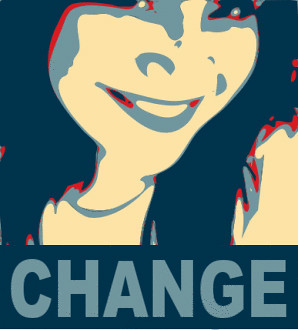News flash: Change is hard. Sustaining change is even harder. I know this because I am in the midst of changing my diet in an effort to improve my health. My family and co-workers will tell you that witnessing this dietary change is not any fun, either. (I repeat the phrase “I am SO hungry” often. I also whine about missing cheese. A lot.)
Motivating Change
Many years ago, in a previous life, I consulted with a health and wellness client to develop some collateral materials encouraging participation in smoking cessation and weight loss programs, as well as a health risk screening initiative. At that time, encouraging wellness practices in the workplace was a new and novel approach, and this client was one of the first to pilot such a program.
We were working with some young, recent college graduates on developing posters and short, informational brochures, trying to encourage participation in the programs and inspire healthy changes in lifestyle. Our lead graphic designer developed some sharp, professional materials, which we presented to our young clients. They brushed them off with little comment and produced some very different concepts to show us — ones that were not attractive and were kinda scary looking, in all honesty.
We were perplexed. Who would want to hang these bizarre photos on their bulletin board? Well, here’s the lesson — our young colleagues informed us that “research shows that generating fear and eliciting a negative reaction was an effective approach to inspiring healthy changes… ” (That phrase was most definitely a foreshadowing of things to come in my position here with Marketing Partners. Only now I know that’s only half the story on promoting positive change.) Think about all of the controversial ads to encourage people to quit smoking, for example.
Marketing Change
So this realization was startling — as my prior communications and marketing work had entailed packaging and writing about industrial environmental work and civil engineering projects and making them sound and look interesting, sophisticated, attractive even. So it was quite the learning experience: effective communications and motivating change isn’t always about improving or elevating a message or an image.
Motivating real change has to appeal to our deeper and emotional instincts — not just our intellect or logic. I realize this is at the center of my own behavior change — my old diet and eating habits created fear about my future health. And the book I read (Eat To Live, by Dr. Joel Furhman) was first and foremost educational, but also confirmed my fears and suspicions about what nasty changes were taking place in my body. This particular book also appealed to another base instinct, however: it created hope. It made me believe that I could change, and these changes would have a healthy effect. Now I understand that although fear may create an emotional reaction that starts a change behavior, the “experts who study behavior change agree that long-lasting change is most likely when it’s self-motivated and rooted in positive thinking.”
So, all this emotional change communication, in fact, worked. I’ve been at it for five weeks now. Does it make change any easier? No. But it really is no news flash that change is hard. The news flash is that it is all worth the effort, and now I know I can succeed.
Related Resources
Why It’s Hard to Change Unhealthy Behavior, Harvard Health
Promoting Healthy Behavior, Health Bulletin (pdf)
Guide to Behavior Change, U.S. Health & Human Services Control
Promoting calls to a quitline: quantifying the influence of message theme, strong negative emotions and graphic images in television advertisements, Tobacco Control




